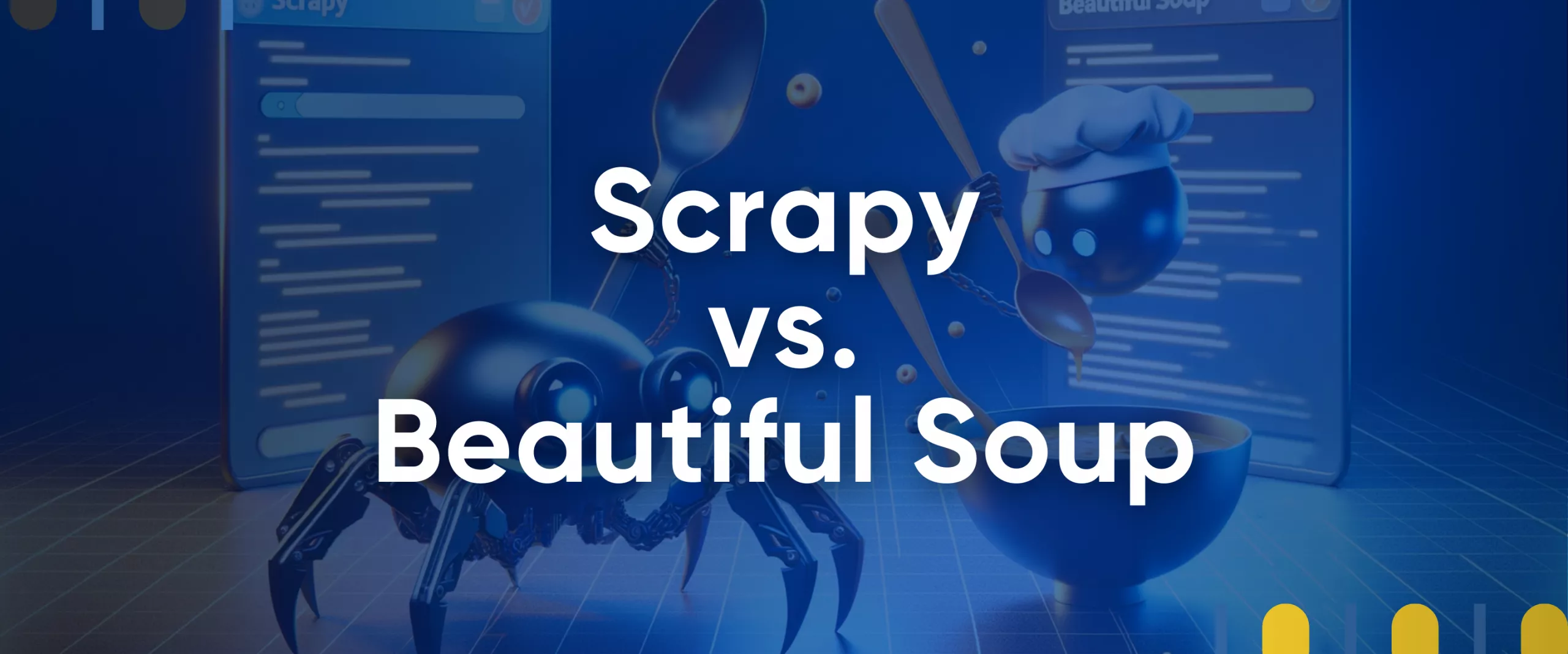Choosing the right web scraping library is as important as choosing the programming language itself. Python offers a wealth of choices for web scraping, with BeautifulSoup and Scrapy being two powerful options. Each library has its own distinct advantages and drawbacks.
This article provides a comprehensive comparison of both libraries, covering their features, pros, and cons. By the end, you'll be equipped to make an informed decision about which library is best for your specific needs.
Get fast, real-time access to structured Google search results with our SERP API. No blocks or CAPTCHAs - ever. Streamline your development process without worrying…
Gain instant access to a wealth of business data on Google Maps, effortlessly extracting vital information like location, operating hours, reviews, and more in HTML…
BeautifulSoup Library
Beautiful Soup is a powerful Python parsing library that simplifies HTML processing. In another article, we've previously explored web scraping with BeautifulSoup. Here, we'll focus solely on the library's functionality, advantages, and disadvantages without delving into code examples.
Features
Beautiful Soup (bs4) is a Python library for parsing HTML and XML documents. It provides several features that make it easy to extract information from web pages, including:
- Parsing HTML and XML. BeautifulSoup can parse HTML and XML documents, making it a versatile tool for working with different data types.
- Navigating the document tree. It allows you to easily navigate the document tree using methods such as finding elements by tag name, CSS class, or ID.
- Searching and filtering. BS4 provides powerful tools for searching and filtering the document tree, allowing you to find specific elements or data.
- Modifying the document. The library allows you to modify the document tree, adding, removing, or changing elements and attributes.
- Prettifying the output. BeautifulSoup can format the document tree in a visually appealing way, making it easier to read and understand.
This set of features provides a comprehensive solution for parsing. Now, let's explore its advantages and disadvantages to compare it with other available tools.
Advantages
Beautiful Soup stands out among web scraping libraries for its simplicity and ease of use. It is known for its user-friendly syntax, making it easy to learn and use, even for beginners. This makes it an excellent choice for those starting with web scraping or data extraction.
Moreover, bs4 is compatible with both Python 2 and Python 3, ensuring seamless integration with different Python versions. This compatibility particularly benefits developers working on legacy projects or transitioning to newer Python versions.
As it is designed to handle "dirty" code, it can effectively process virtually any data format. This includes poorly formatted HTML, allowing you to extract data from complex web pages easily.
Finally, BeautifulSoup has a large and active community of users and developers. This translates to extensive resources, comprehensive documentation, and continuous support for the library. The growing user base further ensures the library's longevity and relevance.
Overall, its user-friendliness, cross-version compatibility, robustness, and active community make it a compelling choice for web scraping tasks.
Disadvantages
While BeautifulSoup is a popular and powerful library for web scraping, it has some drawbacks. First, it prioritizes ease of use over speed, making it less performant than other libraries for large-scale scraping tasks.
As we said before, this library is not designed to handle JavaScript, which is often used in modern web applications. To extract data from such websites, you may need to use a different library or framework like Selenium.
While BS4 is synchronous, it can't handle concurrent or asynchronous requests efficiently for these tasks. So, your code may be slow and not effective. If you want to solve this problem, consider using an asynchronous library like Pyppeteer.
In short, BeautifulSoup is an excellent choice for simple web scraping tasks but may not be the best option for large-scale, complex, or asynchronous scraping.
Scrapy Framework
Scrapy is a full-fledged web scraping framework but not a library. It can help you to build individual scrapers called spiders. We've covered the details of configuring and using spiders in our article on using Scrapy for web scraping.
Features
Originally, Scrapy was developed to create a large number of spiders that could extract large amounts of resources and be easily scalable. Due to this, Scrapy project has several fairly specific functionalities:
- Modular structure. Scrapy uses a modular architecture, which makes it easy to customize and extend its functionality.
- Supports both XPath and CSS selectors. Unlike bs4, Scrapy supports both XPath and CSS selectors for flexible and more accurate data extraction from HTML documents.
- Item pipelines. Scrapy provides a robust pipeline system for processing and saving data in various formats, such as JSON, CSV, or databases.
- Asynchronous requests. The framework supports asynchronous requests, so it can do multiple requests, which improves the scraping speed and efficiency of the web scraping process.
- Built-in support for cookies and sessions. Scrapy simplifies the management of cookies and sessions during scraping data, making it easier to work with the state. It's worth noting that not every scraping library has such functionality.
As you can see, Scrapy's functionality is extensive and aimed at maximizing the efficiency of the scraping process. However, to be able to compare it with BeautifulSoup, we should also talk about its pros and cons.
The Google SERP API library is a comprehensive solution that allows developers to integrate Google Search Engine Results Page (SERP) data. It provides a simplified…
The Google Maps API Python library offers developers an efficient means to harness detailed location data directly from Google Maps. This library simplifies the…
Advantages
As mentioned, Scrapy was designed with large-scale scraping projects in mind. It boasts excellent scalability thanks to its asynchronous processing and modular architecture.
Furthermore, the framework is highly extensible, allowing developers to add custom functionality and integrate third-party libraries. Scrapy's extensive and well-organized documentation simplifies the learning and usage process.
If you encounter difficulties, the active community support is a compelling reason to choose Scrapy. As an open-source project, it benefits from regular updates, community contributions, and prompt assistance in case of problems.
Disadvantages
The most obvious and clear disadvantage of Scrapy is its relatively high complexity. Due to its rich feature set, Scrapy may require more time for beginners to master compared to simpler web scraping tools. Unfortunately, this makes this framework not recommended for beginners.
It is also worth considering that large-scale web scraping operations can consume significant system resources. Therefore, when using this framework, you will also have to think about ways to manage available resources to prevent performance problems effectively.
Overall, Scrapy is a powerful framework, but it may not be suitable for everyone. It requires a significant investment in time and effort to learn and use effectively.
Should I use BeautifulSoup or Scrapy?
Beautiful Soup and Scrapy are both popular Python libraries used for web scraping, but they serve different purposes and have distinct features. Choose between them based on the scale and complexity of your web scraping project, as well as your preference for ease of use versus comprehensive functionality.
To help you make an informed choice, we have created a table with the key parameters to consider when choosing a tool:
|
Feature |
Beautiful Soup |
Scrapy |
|---|---|---|
|
Purpose |
HTML, XML parsing |
Comprehensive web crawling framework |
|
Ease of Use |
Simple and intuitive |
Requires a learning curve |
|
Flexibility |
Limited to parsing |
Extensive, supports crawling and parsing |
|
Project Size |
Small to medium-scale |
Large-scale and complex scraping tasks |
|
Scalability |
Handling a massive number of requests can become overwhelming |
Can efficiently manage millions of URLs and efficiently extract data |
|
Asynchronous Support |
No |
Yes, built-in support for asynchronous processing |
|
Built-in Functionality |
Basic parsing and navigation |
Handling cookies, redirects, retries, and more |
|
Speed |
Fast |
Medium |
|
Community Support |
Widely used for parsing |
Popular for various web scraping tasks |
In short, Beautiful Soup is ideal for simpler tasks and parsing data from HTML or XML, while Scrapy is the preferred choice for more extensive and complex web scraping projects that involve crawling through multiple pages and require scalability.
Ultimately, the best scraping library for you will depend on your specific needs. Consider the factors listed above and then research to find the library that is right for you. It is also possible to use multiple libraries together. For example, Scrapy can efficiently crawl through product listings on different pages. But to extract details like product title, description, and price from each listing, you can use BeautifulSoup within your Scrapy spider to parse the HTML structure of individual product pages and pinpoint the elements containing that data.


